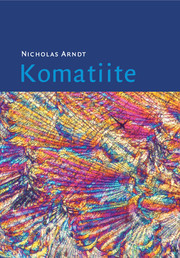Book contents
- Frontmatter
- Contents
- Preface
- Part I Background information – description of the field characteristics, mineralogy and geochemistry of komatiites
- Part II Interpretation – the manner of emplacement, the origin and the tectonic setting of komatiites
- 8 Physical properties of komatiites
- 9 Physical volcanology (by S. J. Barnes and C. M. Lesher)
- 10 Komatiite-associated Ni–Cu–PGE deposits (by C. M. Lesher and S. J. Barnes)
- 11 The hydrous komatiite hypothesis
- 12 Compositions and eruption temperatures of komatiitic liquids
- 13 Petrogenesis of komatiite
- 14 Geodynamic setting
- References
- General index
- Localities
- Plate section
8 - Physical properties of komatiites
from Part II - Interpretation – the manner of emplacement, the origin and the tectonic setting of komatiites
Published online by Cambridge University Press: 27 August 2009
- Frontmatter
- Contents
- Preface
- Part I Background information – description of the field characteristics, mineralogy and geochemistry of komatiites
- Part II Interpretation – the manner of emplacement, the origin and the tectonic setting of komatiites
- 8 Physical properties of komatiites
- 9 Physical volcanology (by S. J. Barnes and C. M. Lesher)
- 10 Komatiite-associated Ni–Cu–PGE deposits (by C. M. Lesher and S. J. Barnes)
- 11 The hydrous komatiite hypothesis
- 12 Compositions and eruption temperatures of komatiitic liquids
- 13 Petrogenesis of komatiite
- 14 Geodynamic setting
- References
- General index
- Localities
- Plate section
Summary
Introduction
Komatiitic liquids have extreme chemical compositions, being very rich in MgO and poor in SiO2, Al2O3 and alkalis. Given these compositions, their physical properties must have been very different from those of basalts and other more familiar types of magma. Although it should be possible to measure these properties in the laboratory on molten natural komatiites, there will always remain some uncertainty as to whether the sample chosen accurately represents a real komatiite liquid: the familiar problems of volatile content, excess olivine component and the effects of post-emplacement alteration will always introduce an element of doubt. To my knowledge little direct work of this type has been done. As discussed in Chapter 7, a series of experiments has been conducted to measure the density of komatiite at high pressure in order to investigate whether the density of ultramafic liquid exceeds that of common mantle minerals. Liquidus temperatures at atmospheric pressure, and the relationship between temperature and crystal content, have also been established experimentally, but no systematic measurements of the density and viscosity of komatiitic liquids at low pressure appear to have been made.
Certain rheological properties can be inferred from the structures and textures of natural komatiites, but, as will become clear in Chapter 9, the interpretation of such textures is often ambiguous, and in many cases the interpretation hinges on assumptions about the nature of the komatiite liquids themselves.
- Type
- Chapter
- Information
- Komatiite , pp. 235 - 242Publisher: Cambridge University PressPrint publication year: 2008



